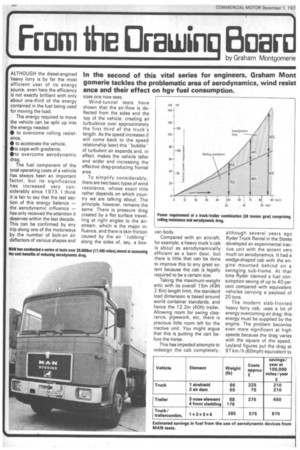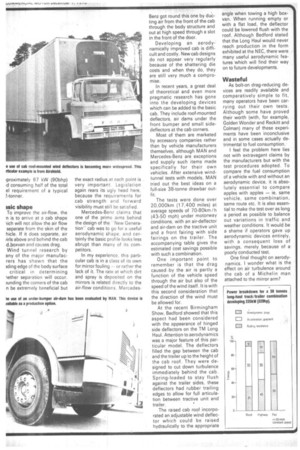( From the
Page 70

Page 71

If you've noticed an error in this article please click here to report it so we can fix it.
ALTHOUGH the diesel-engined heavy lorry is by far the most efficient user of its energy source, even here the efficiency is not exactly brilliant with only about one-third of the energy contained in the fuel being used for moving the load.
The energy required to move the vehicle can be split up into the energy needed: • to overcome rolling resistance, • to accelerate the vehicle. Co cope with gradients, • to overcome aerodynamic drag.
The fuel component of the total operating costs of a vehicle has always been an important factor, but its significance has increased very considerably since 1973. I think it is fair to say that the last section of this energy balance — the aerodynamic influence — has only received the attention it deserves within the last decade. This can be confirmed by any trip along one of the motorways by the number of bolt-on air deflectors of various shapes and sizes one now sees.
Wind-tunnel tests have shown that the air-flow is deflected from the sides and the top of the vehicle, creating air turbulence over approximately the first third of the truck's length. As the speed increases (I will come back to the speed relationship later) this "bubble'' of turbulent air expands and, in effect, makes the vehicle taller and wider and increasing the effective drag-producing frontal area.
To simplify considerably, there are two basic types of wind resistance, whose exact title rather depends on which country we are talking about. The principle, however, remains the same. There is pressure drag created by a flat surface travelling at right angles to the airstream, which is the major influence, and there is skin friction caused by the air "rubbing" along the sides of, say, a box
van body.
Compared with an aircraft, for example, a heavy truck's cab is about as aerodynamically efficient as a barn door, but there is little that can be done to improve this to any great extent because the cab is legally required to be a certain size.
Taking the maximum-weight artic with its overall 15m (49ft 2.6in) length limit, the standard load dimension is based around world container standards, and hence the 12.2m (40ft) trailer. Allowing room for swing clearance, pipework, etc, there is precious little room left for the tractive unit. You might argue that this is putting the cart before the horse.
This has impeded attempts to redesign the cab completely, although several years ago Ryder Truck Rental in the States developed an experimental tractive unit with the accent very much on aerodynamics. It had a wedge-shaped cab with the engine mounted behind on a swinging sub-frame. At that time Ryder claimed a fuel consumption saving of up to 40 per cent compared with equivalent vehicles carrying a payload of 20 tons.
The modern slab-fronted heavy lorry cab, uses a lot of energy overcoming air drag: this energy must be supplied by the engine. The problem becomes even more significant at high speeds because the drag varies with the square of the speed. Leyland figures put the drag at 97 km /h (60mph) equivalent to 'proximately 67 kW (90bhp) id consuming half of the total el requirement of a typical ?-tonner.
asic shape To improve the air-flow, the ri is to arrive at a cab shape -doh will not allow the air flow separate from the skin of the hide. If it does separate, air rids above and behind the cab boxvan and causes drag. Wind tunnel research by any of the major manufacrers has shown that the 3ding edge of the body surface critical in determining -iether separation will occur. )unding the corners of the cab n be extremely beneficial but
the exact radius at each point is very important Legislation again rears its ugly head here, because the requirements for cab strength and forward visibility must still be satisfied.
Mercedes-Benz claims that one of the prime aims behind the design of the "New Generationcab was to go for a useful aerodynamic shape, and certainly the basic profile looks less abrupt than many of its competitors.
In my experience, this particular cab is in a class of its own for mirror fouling — or rather the lack of it. The rate at which dirt and spray is deposited on the mirrors is related directly to the air-flow conditions. Mercedes Benz got round this one by ducting air from the front of the cab through the body structure and out at high speed through a slot in the front of the door.
Developing an aerodynamically improved cab is diffi
cult and costly. New cab designs do not appear very regularly because of the shattering die costs and when they do, they are still very much a compromise.
In recent years, a great deal of theoretical and even more pragmatic research has gone into the developing devices which can be added to the basic cab. They include roof-mounted deflectors, air dams under the front bumper and small sidedeflectors at the cab corners.
Most of them are marketed by accessory companies rather than by vehicle manufacturers themselves, although MAN and Mercedes-Benz are exceptions and supply such items made specifically for their own vehicles. After extensive wind tunnel tests with models, MAN tried out the best ideas on a Full-size 38-tonne drawbar outfit.
The tests were done over 20,000km (17,400 miles) at average speeds of 70-80km /h (43-50 mph) under motorway conditions, with an air-deflector and air-darn on the tractive unit and a front fairing with side fairings on the trailer. The accompanying table gives the estimated cost savings possible with such a combination.
One important point to remember is that the drag caused by the air is partly a function of the vehicle speed through the air but also of the speed of the wind itself. It is with this second consideration that the direction of the wind must be allowed for.
At the recent Birmingham Show, Bedford showed that this aspect had been considered with the appearance of hinged side deflectors on the TM Long Haul. Attention to aerodynamics was a major feature of this par ticular model. The deflectors filled the gap between the cab and the trailer up to the height of the cab roof. They were de signed to cut down turbulence immediately behind the cab. Spring-loaded to stay flush against the trailer sides, these deflectors had rubber trailing edges to allow for full articulation between tractive unit and trailer.
The raised cab roof incorporated an adjustable wind deflec tor which could be raised hydraulically to the appropriate angle when towing a high boxvan. When running empty or with a flat load, the deflector could be lowered flush with the roof. Although Bedford stated that the Long Haul would never reach production in the form exhibited at the NEC, there were many useful aerodynamic features which will find their way on to future developments.
Wasteful As bolt-on drag-reducing devices are readily available and comparatively simple to fit, many operators have been carrying out their own tests. Although some have proved their worth (with, for example, Golden Wonder and Reckitt and Colman) many of these experiments have been inconclusive and in some cases actually detrimental to fuel consumption.
1 feel the problem here lies not with extravagant claims by the manufacturers but with the test procedures adopted. To compare the fuel consumption of a vehicle with and without an aerodynamic device, it is absolutely essential to compare apples with apples — ie, same vehicle, same combination, same route etc. It is also essential to make the test over as long a period as possible to balance out variations in traffic and weather conditions. It would-be a shame if operators gave up aerodynamic devices entirely, with a consequent loss of savings, merely. because of a poorly conducted test.
One final thought on aerodynamics. I wonder what is the effect on air turbulence around the cab of a Michelin man attached to the mirror arm?


































































































































